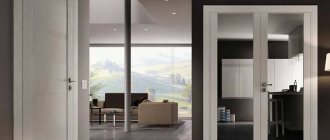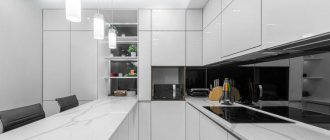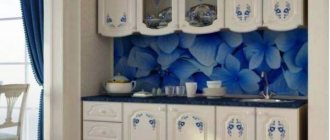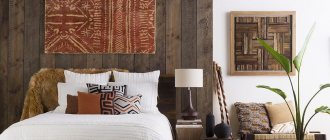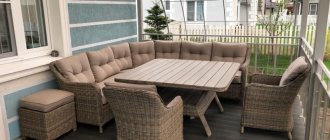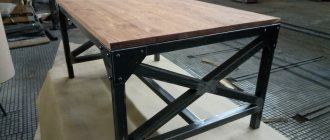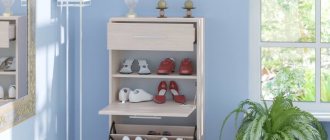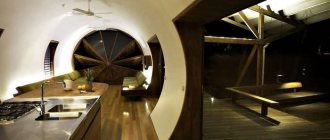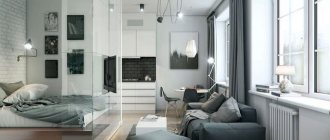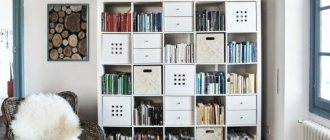Indoor flowers as part of the interior
When designing a living space, it is worth noting that the design should not only please the eye, but also provide comfort. The arrangement of flowers in the interior of the apartment should be organized so that the room is not cluttered, but its advantages are emphasized. An interior with flowers in an apartment looks more comfortable and has undeniable advantages:
- an abundance of greenery relieves eye fatigue and helps you relax after a hard day at work;
- fresh flowers regulate humidity and purify the air;
- plants can optically change the proportions of a room.
It doesn’t matter whether you use fresh flowers in the interior of your home or use artificial analogues, you must adhere to the recommendations listed below. Plants, regardless of their origin, must:
- correspond to the dimensions of the room;
- combine with existing furnishings and decoration;
- harmonize with the color scheme and the general concept of interior design.
Important! Owners of miniature rooms should take into account that a composition containing large plants in the background and smaller ones in front of them creates the illusion of perspective and visually expands the space.
Scandinavian clean lines
In the Scandinavian interior, indoor plants carry the same load as large designer accessories: they give minimalism the charm of elitism. Each plant is “presented” so that it is the center of attention.
What new things have the trendsetters in the field of design enriched this style with? Lawns came into the interior. They have been used before in the Scandinavian style, but only selectively. Now the lawn is given a wall, a podium, and some other significant spaces. In continuous landscaping, cereals, moss, hanging plants and low leafy plants are used.
Interior landscaping in Scandinavian style
It was in the Scandinavian style that vertical hanging gardens were first used. They are framed like a painting. They create a picturesque carpet of stems and leaves of different textures. Built into niches. They replace the walls.
Vertical flower bed in a Scandinavian interior
Florariums – inventive mini-greenhouses for dwarf plants – effectively and organically complement the decor.
An extravagant way to present plants is hanging flowers from the ceiling. And a completely surreal example of phyto-interior design - inverted pots with stems growing downwards.
Fresh flowers in pots
Real greenery placed in the room will be a win-win for those who like plants and are willing to care for them. Unpretentious dracaenas, delicate orchids, popular ficus and palm trees have become familiar neighbors in our residents. When placing fresh flowers on the wall in the interior, on shelves or in the window area, consider the following recommendations:
- Don't settle for the traditional option of placing plants using a window sill. Create compositions using stands, racks, and place pots directly on the floor.
- Do not make compositions from traditional and fashionable house plants. For example, “grandmother’s” violets can easily be replaced with azaleas.
- When creating a floral interior in an apartment, pay attention to the colors of the pots. They should be combined with each other, in harmony with the interior. A win-win option would be delicate pastel colors that will fit perfectly into any interior.
Heroes of eco-design – all areas of country style
What did the fashion trend of “new botany” give to the country style, in which flowers and green plants were traditionally present? First of all, he raised the status of the country music genre. Secondly, the developments of the new wave gave interior designers fresh ideas and magnificent floral accessories - stands, whatnots, jardinieres, flowerpots.
It would be a slight exaggeration to say: there are so many country style trends. Let's consider techniques for using indoor flowers and plants in the interior of city apartments with rural design.
Flowers and scents of Provence
In the French provincial style of Provence, flowering crops are in the lead:
- roses;
- violets;
- geranium;
- oleander;
- bulbous - tulips, hyacinths, daffodils, crocuses;
- mini-lawns in pots made of cereals, lavender, herbs.
- as well as evergreen laurel, ficus, etc.
Violets will fit perfectly into a romantic interior in Provence style
The peculiarity of Provence is the adaptation of a variety of containers as flower pots and ingenuity in their handicraft decoration. They are painted, aged, covered with craquelure and patina.
An important element is the abundance of shelves, jardinieres, shelves and improvised pedestals for plants. In Provence, it is customary to place flower pots on the windowsill, on the kitchen sink or dining table.
In Provence, it is customary to place flower pots on the windowsill
American country
The least affected by new landscaping ideas is American country music; this style is incredibly conservative. A few wooden or ceramic plant pots are more than enough to liven up your farmhouse interior.
Several plants in ceramic pots will decorate a country-style interior
Japanese mini gardens
In the tradition of Japanese interior - admiring plants, stones, wood. All three elements are present in living plant compositions in the Japanese style.
Bonsai for a laconic interior in Japanese style
Plants in Japanese interiors are never presented without a frame. A wooden stand, a clay or wooden pot, stones and sand covering the ground, a lone bonsai tree or a plant composition - all this makes up a single whole.
Mediterranean style: blooming shore
A sunny Mediterranean interior with elements of rough antiquity is filled with special charm when southern flowers and plants settle in it - indoor cypresses, papyrus, oleander, ivy, roses, etc.
Indoor cypress trees
Ceramics, stone, mosaics, wood, metal, fabrics and ropes are used in the design of pots.
Artificial
Artificial greenery will be a wonderful solution for those who want to diversify their interior, but do not have the opportunity to fully care for living plants. When composing compositions, do not occupy all the window sills and corners with pots, use your imagination. For example, artificial flowers on the wall will look original. Before you start, read the advice of professionals:
- An arrangement of artificial plants will look great on a coffee table - it doesn’t need a lot of light, and the covering won’t deteriorate, since they don’t need to be watered.
- Tall flowers look great in floor vases. This solution will be an excellent decoration for the living room or hallway.
- Artificial climbing plants can be beautifully placed on the wall. They will not deteriorate from lack of light, they will not have to be sprayed, which will help preserve the finish.
What designers surprised us with in 2022
Summing up the fashionable review of plant design in the interior, we will highlight new items, discoveries and the most important trends.
- An interior without plants is not modern.
- There are never too many plants.
- Autonomous closed phytosystems have opened a new era in apartment design.
- A phytowall with auto-irrigation is the main find of 2022.
- Florariums and microgreenhouses are favorites of designers.
- The most unexpected technique is to grow plants upside down.
- Moss has come to interior design.
- The most fashionable decorative plants in the interior are poisonous.
- Stabilized plants do not differ from real ones, do not require care, and last for 5-6 years.
- Artificial flowers turn out to be stylish.
- A cut leaf in a vase competes with a bouquet of flowers.
It's hard to imagine a modern interior without plants
When a new wave sweeps into fashion, designers' recommendations are full of categoricalness, and conceptual models are full of exaggeration. This is the law of the genre: in order to accept something new, you must experience shock.
Subsequently, everything will become more democratic and harmonious, but for now, at the turning point of fashion trends, we find ourselves under a kind of pressure: either we urgently need to select plants for the interior, or we will have to join the ranks of retrogrades.
However, compromise solutions have already been proposed, and choosing your own style is perhaps the most interesting thing in the world of fashion.
Large
Large flowers in the home interior feel great in spacious, free areas. They will be a wonderful decoration for rooms equipped with floor-to-ceiling windows. Species whose size exceeds 1.5 meters are considered large. Individual plants can reach the ceiling.
Large flowers can be placed separately or become part of a composition with smaller counterparts. Such ensembles are an excellent solution for recreation areas, as they can create a unique atmosphere for relaxation. When planning to use such options, consider some nuances:
- You should not place large plants on windowsills - they will look bad there and lack light;
- flower pots play a big role; they must be in harmony with the decor and fit into the design concept of the room;
- large plants with a spreading crown will optically enlarge the room, tall specimens will visually raise the ceiling.
Basics of phytodesign
The easiest way to green your interior is to seek help from an experienced designer. But this can be expensive, and furnishing your home yourself is much more pleasant. Although it will not meet all the rules of interior design, it will definitely acquire uniqueness and reflect the character of the owner. And to do this competently, you need to familiarize yourself with the basic nuances of phytodesign.
When choosing plants, you need to remember that they not only decorate the premises, but also require special conditions and proper care. But that’s not all: some crops can be harmful and even life-threatening for family members. For example, very often you can find Dieffenbachia in the interiors of residential buildings. But it is not recommended to install it if there are small children or animals in the family - the juice of the plant is quite poisonous.
Choose plants that have a positive effect on human well-being. Decorate your interior with these crops, and you will forever forget about stress and poor health:
- Lavender is a real antidepressant. It relieves headaches, helps you fall asleep faster and get rid of anxious thoughts. The pleasant smell of flowers reduces high heart rate and relaxes.
- Physalis is a very bright and beautiful plant with expressive fruits. But in addition to its attractive appearance, it is also very uplifting.
- Geranium has such a fragrant scent that it can significantly reduce anxiety levels.
- Peppermint is a plant used everywhere. You can even find mint chocolates on sale, let alone interior decor. It relieves fatigue and irritability, and in the course of research by psychologists it was even found that mint helps fight depression.
- Rose is a very beautiful plant that has become a symbol of love and attention. Bouquets of roses add romance and luxury to the interior, and give the owner a good mood.
- Aloe is another crop that can compete with mint in popularity and breadth of use. Aloe is used in medicine and cosmetology, and even helps with weight loss. The juice of this plant is indicated for chronic gastritis and loss of appetite. And in the interior it perfectly purifies the air, fills it with oxygen and helps you fall asleep. In ancient Egypt, it was believed that aloe could drive away evil spirits.
Another interesting feature of some crops is the ability to purify the air, removing dangerous fumes from it. If you have recently painted the walls, carried out renovations, or your room faces the roadway, filter plants will come in handy more than ever.
In 1989, NASA conducted a study that identified the best plants for cleaning rooms. Some of them can neutralize air pollution by more than 85%. The best purifying plants that look interesting and decorate the interior:
- Anthurium Andre humidifies the air, purifying it of harmful xylene and converting it into safe chemical compounds.
- Golden lotus is perfect for installation in the shade. It purifies the air from formaldehyde and benzene. However, it is worth remembering that this plant is very poisonous, so keep it away from children and animals.
- Chlorophytum. The plant received another name, “spider,” due to its long, spreading leaves. Eliminates benzene and formaldehyde, in addition, it is completely safe for children and animals.
- Climbing ivy. Another great choice for dimly lit rooms. The shade-loving plant actively fights against benzene, formaldehyde and carbon monoxide, and also eliminates mold.
Fashionable
Today, randomly arranged flowers in a room, the interior of which is created with the latest fashion trends, are replacing stylish compositions. Miniature vegetable gardens located on the wall or on the windowsill and florariums are popular. Predatory flowers, rare exotic plants, and giant specimens will bring a special flavor to the room.
Large-sized trees will help you create a home greenhouse: dracaena, palm, coffee tree. Floor planters for flowers in the interior help to visually change the configuration of the room and hide imperfections. If you line them up in a row, you get a hedge that allows you to separate functional areas.
Using florariums (aquariums for plants) it is easy to create a miniature garden that will allow succulents, orchids, and ferns to thrive.
Beautiful indoor flowers
Home flowers in the interior should not be the result of impulsive purchases. When planning to purchase them, it is worth thinking through the compositions in advance and taking the choice of copies seriously. In addition, it is worth assessing the compliance of the chosen location with the plant’s habitat conditions and its functional significance.
Most plants will look beautiful only with sufficient lighting, this should be taken into account when purchasing, arrange the flowers so that they receive enough sun or organize additional lighting, which is associated with costs.
For kitchen
Flowerpots in the kitchen interior will allow you to diversify the design and create accents that are pleasing to the eye. Many plants can easily coexist on the windowsill, from the usual violets to exotic ferns.
A feature of the kitchen is temperature changes and high humidity. It is worth selecting plants taking into account these parameters. Such conditions will provide excellent habitat for:
- aloe;
- ficus;
- ivy;
- miniature fruit trees.
When planning your kitchen design, keep in mind that plants should be organized and look neat. They can be placed directly on the table instead of cut ones. Flowers should look healthy and free of pests. Sharp, intoxicating aromas are unacceptable for this room.
For the bedroom
You can use a wide variety of pieces to decorate your bedroom. Plants are easy to place on the floor, window sills, or create a composition on a wall, bedside table, or coffee table.
Since the bedroom is a place for relaxation, where we spend a lot of time, it is worth avoiding species whose representatives are capable of releasing toxic substances. This will lead to constant headaches and malaise. You should not choose flowers with a rich aroma. Also, experts do not recommend using lilies, which actively absorb oxygen, to decorate the bedroom. The ideal option for the bedroom would be:
- spathiphyllum;
- violet;
- myrtle;
- Kalanchoe.
When choosing an option for the bedroom, you do not have to worry about the opinions of guests, since they rarely visit this room. You can create a composition to your taste and enjoy it.
For dark rooms
If the apartment is located on the north side, its windows are covered with tree crowns, choose plants that can easily tolerate shade. Decorative foliage options tolerate darkening perfectly and will decorate a room shrouded in twilight.
It is easy to place such a composition in any convenient place. Can be placed on a windowsill, placed on a wall or on the floor. Experts note shade-loving plants that have become popular:
- philodendron;
- fern;
- scindapsus;
- aglaonema.
When choosing a shade-loving specimen, keep in mind that it can be located on a windowsill if it is not exposed to direct rays of the sun. Depending on the lighting, the green pet can be placed at a distance of 3 to 9 meters from the window. A standard apartment can provide maximum distance from bright light by placing the plant at the end of the hallway or bathroom.
For the bathroom
Taking water treatments surrounded by living plants is doubly pleasant. Specimens that prefer darkness and high humidity will get along well here. If there is no window in the bathroom, you will have to periodically take the plants out into the light and add additional lighting. The following plants will be comfortable in the bathroom:
- tropical species;
- fern;
- ficus;
- chlorophytum.
Important! The bathroom is a place that is undeservedly forgotten by lovers of house plants. A miniature room can be decorated with small plants located on shelves. If you have an impressively sized bathroom, diversify the regular shapes with an exotic tree in a tub.
In the living room
Flowers in the living room will be an excellent solution when it is quite free and not overloaded with various furniture. Having opted for large specimens, such as dracaena, yucca, it is easy to optically further expand the space.
By choosing hanging plants, small perennials, as well as climbing and weaving options for the living room, you can create a comfortable, cozy atmosphere in the room. When arranging the composition, take into account the characteristics of the plants, moving the light-loving ones closer to the light source.
In the hall
Species that are able to develop even with a lack of light will be comfortable here. Plants should have strong leaves, insensitive to constant touching, and lush bushes. It is important that the pots in which the flowers are placed are low and heavy, resistant to tipping over.
Ficus, fern, Hederes ivy, and cissus will be luxurious decorations for the hallway. However, even such shade-tolerant plants need to be periodically moved to a sunny place. Otherwise, they will lose their decorative effect and die. An alternative option is to use artificial greenery.
General recommendations for selection and care
In order for plants to delight and delight guests and owners, it is necessary to provide them with comfortable living conditions. The determining factor for rapid growth is the cardinal direction:
North. Dieffenbachia, cyclamen, anthurium, aspidistra, ficus, aglaonema, fittonia, clivia and monstera are suitable for cultivation.
South. It is worth considering succulents (prickly pear, haworthia, schlumbergera, crassula), as well as jasmine, hibiscus, rose and citruses. Plants must be shaded from direct sunlight, and ventilation must be provided.
West. Asparagus, sansevieria, cissus, eucalyptus, codeum, cattleya, saintpaulia, fuchsia, rheo, spathiphyllum and groundsel are suitable.
East. This is the most optimal side for green pets. You can install flowerpots with stephanotis, clerodendrum, myrtle, geranium, etc.
Indoor plants are replanted in the spring (late February - April). At this time, they awaken from their dormant state and begin to grow shoots. You cannot replant greens at the time of flowering or immediately after purchase. A universal scheme for the process: young plants up to 3 years old are moved to a new flowerpot annually, adult specimens - after 2-3 years.
It is better to replant flowers in a pot slightly larger than the previous one, rather than immediately into a larger container. Some plants (orchids, hippeastrums) prefer tight containers. An excessively spacious place of residence can cause a lack of flowering. Transshipment is considered the least painful method of transplantation. In this case, the earthen clod is transferred to a new flowerpot with soil added to the sides of the pot.
Where to put flowers in an apartment: tips
When starting landscaping, keep in mind that plants must be placed taking into account the peculiarities of their care and design rules. When choosing a place for permanent habitat, study the conditions that will be optimal for its development.
Flowering specimens often prefer a well-lit area; ferns and representatives of the dracaena family can thrive in shaded conditions.
How to place flowers on the windowsill?
The window sill remains the most common option for placing plants. Windows facing south, west or east are best suited for this. The north side will be a good solution for greenery that prefers shade.
The south side, constantly illuminated by bright sun, is an excellent option for succulents, cacti, oleander, and roses. On the western side, citrus fruits, tradescantia, and coffee will be comfortably located. Eastern - will become a cozy place for azaleas, dieffenbachia, fuchsia, and bulbous ones.
Placing flowers on the floor
Natural greenery will thrive on the floor as long as it is tall enough and receives the right amount of light. A large, heavy pot will make the flower unsafe if placed on a table or windowsill.
The best solution to place the plant on the floor is when purchasing decorative dwarf trees or tall vines. By placing them symmetrically near the door, you can add symmetry to the room, making them a group - moving part of the garden into the house.
Placing plants on a stand
Flowers with hanging branches and curved leaves deteriorate when placed on the surface of a windowsill, cabinet, or shelf. Their decorative effect is revealed only when using various stands. Hanging containers and floor structures allow you to create compositions in any part of the room.
When choosing an option for placing greenery, keep in mind that they can be:
- in the form of a miniature table on a leg;
- speakers made of wood, metal, smoky glass;
- rod holders made of forged metal, plastic, wood;
- grilles that help divide the room into zones.
Placing flowers on the walls
The wall turns into a green zone when it is necessary to create a bright accent in the room and give it individuality. To keep the air moist and not spoil the finish, select deep vessels equipped with a capacious tray.
Flowers in the living room, the design of which you plan in advance, should be in harmony with the surface on which they will be placed:
- Lush greenery and bright flowers will look great on delicate, pastel surfaces. Plants with variegated leaves and numerous pale flowers will be lost against such a background, but will look great on a dark wall.
- Avoid specimens with small leaves if you choose a wall with a small pattern as the background. Species with large, spreading foliage will look great on it.
- Combine contrasts and shapes. A strict vertical pattern will enliven a luxurious climbing plant.
Maximalism in everything or the Revival of true luxury
The modern interior of apartments, “brought up” on ascetic minimalism, misses luxury. This is noticeable in many trends - the return of velvet, damask ornament and lacquer polishing of expensive furniture, in the rich terracotta palette that replaced Marsala, in relation to indoor plants, which have moved from occasional decor into the category of a powerful, conceptual architectural form.
Green oasis of indoor plants
Green areas in the apartment are designed comprehensively. Their role in zoning is thought through, lighting and humidity are checked for compliance, and maintenance is planned. They have become larger, more creative, more diverse.
Vertical green area in the apartment
At the same time, a good modern interior is characterized by some irony and a lack of narcissism. Example? Yes, here it is, in front of you - a little mischief in the kitchen, and not only.
How to choose indoor plants for your home
Greenery allows you to refresh the interior and give the home comfort. Before you make a purchase. It is worth planning what plants you will purchase and where they will be located. Thanks to the variety of types, you can choose an option that will fully match the interior and emphasize its individuality. For example, in a room decorated in a high-tech style, specimens with large, regularly shaped leaves will look great. In addition, it is worth taking care that the conditions in the room are appropriate.
Photophilous
Most flowering plants are considered light-loving. To force buds, they need a sufficient level of lighting, otherwise they will bloom less often and not so abundantly. When choosing options for landscaping a sunny window, it is worth considering where future pets grow in the real environment.
It is easy to identify light-loving species not only by their fleshy leaves or the presence of spines. They often have bright, decorative leaves, the color of which consists of two or more colors. It is worth noting that by placing them in the back of the room, you will not lose your green friend, but its decorative effect will disappear.
Shade-loving
Shade-tolerant specimens are much more difficult to select, but they are easy to care for and thrive in a darkened room. The popularity of creating flower arrangements on walls and special stands is growing, so we have to be stricter in the selection of plants that can withstand the proposed conditions and remain an interior decoration. The illumination provided by artificial lighting is enough for them; they get used to the conditions that the far part of the room can provide.
Bright visual accent
Exotic flowering plants, including orchids, tuberoses, Amazon lilies and other flowers, attract the eye and emphasize the individuality of the home.
